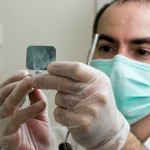
Dry socket (alveolar osteitis) is a common post-operative complication of permanent tooth extraction. Incidence of alveolar osteitis (AO) has been reported to range from 0.5-68.4%. AO may occur up to 10 times more frequently following third molar removal.
The aim of this review was to assess the effectiveness of chlorhexidine in the prevention of AO after third molar extractions.
Methods
Searches were conducted in Medline, the Cochrane Central Register of Controlled Trials, Scopus, Science-Direct, Web of Science, Evidence-Based Dentistry, ClinicalTrials.gov, the European Union Clinical Trials Register, the Spanish General University Board database of doctoral theses in Spain (TESEO), the Spanish National Research Council (CSIC) bibliographic databases, and the Spanish Medical Index (IME) without language restriction.Randomised controlled trials (RCTs) with or without placebo of chlorhexidine in any concentration, formulation, or treatment regimen for preventing AO in patients undergoing extraction of upper or lower third molars were considered.
Two reviewers independently abstracted data from the selected studies. Risk of bias was assessed. The primary outcome was incidence of AO and efficacy summaries using risk ratios (RR), preventive fraction and number needed to treat (NNT). Meta-analysis of binary data was conducted using a fixed-effects model.
Results
- 18 RCTs (16 parallel-group and 2 split-mouth) were included
- There were 2,824 third molar extractions (1,458 in experimental group and 1,366 in control group).
- 10 studies involved rinses, 4 using 0.2% concentration others 0.12%.
- 10 studies used gels, most using 0.2% concentration, 1 using 1%.
- There was a significantly lower incidence of AO in patients treated with chlorhexidine
- RR= 0.53 (95%CI; 0.45-0.62); NNT = 8 (95%CI; 7-11).
- There was little difference between rinse and gel:
- Rinse RR = 0.58; (95%CI; 0.47- 0.71)
- Gel RR = 0.47; (95%CI; 0.37- 0.60)
- 3 studies reported adverse effects including glossitis, bad taste, staining of dentures and oral mucosa and stomatitis
Conclusions
The authors concluded
the use of chlorhexidine in any formulation, concentration, or regimen is efficacious and effective in preventing AO in patients who have undergone third molar extractions. Chlorhexidine gel was found to be moderately more efficacious than the rinse formulation.
Comments
A 2012 Cochrane review by Daly et al (Dental Elf – 13th Dec 2012) looked at local interventions for the management of AO. This new review has undertaken a broad database search and has included 7 new studies published since the Cochrane review. While the authors of this new review have undertaken a quality assessment it is unfortunate that they have not used the full Cochrane risk of bias tool and used the standard approach for displaying the findings as this who have helped the reader. This review includes 4 studies excluded in the Cochrane review. As the authors note the findings of the Cochrane review were similar to this current review with a relative risk for rinse = 0.58(95%CI; 0.43 to 0.78) and RR= 0.42 (95%CI; 0.21 to 0.87).
While this review confirms that chlorhexidine is beneficial in preventing AO. There is still limited data collected on adverse events. Staining, altered taste sensation, burning sensations, hypersensitivity, mucosal lesions and an anaesthetised sensation have been reported as adverse effects of chlorhexidine use and some of these have been reported in studies included in this review. In is also worth noting that two cases of serious adverse events associated with irrigation of dry socket with chlorhexidine mouthrinse have been reported in the UK so clinicians prescribing chlorhexidine products should be aware of the potential for both minor and serious adverse side effects.
Links
Primary paper
Rodríguez Sánchez F, Rodríguez Andrés C, Arteagoitia Calvo I. Does Chlorhexidine Prevent Alveolar Osteitis After Third Molar Extractions? Systematic Review and Meta-Analysis. J Oral Maxillofac Surg. 2017 Jan 13. pii:S0278-2391(17)30020-4. doi: 10.1016/j.joms.2017.01.002. [Epub ahead of print] Review. PubMed PMID: 28189661.
Other references
Dental Elf – 13th Dec 2012
Dental Elf – 29th Jun 2012
